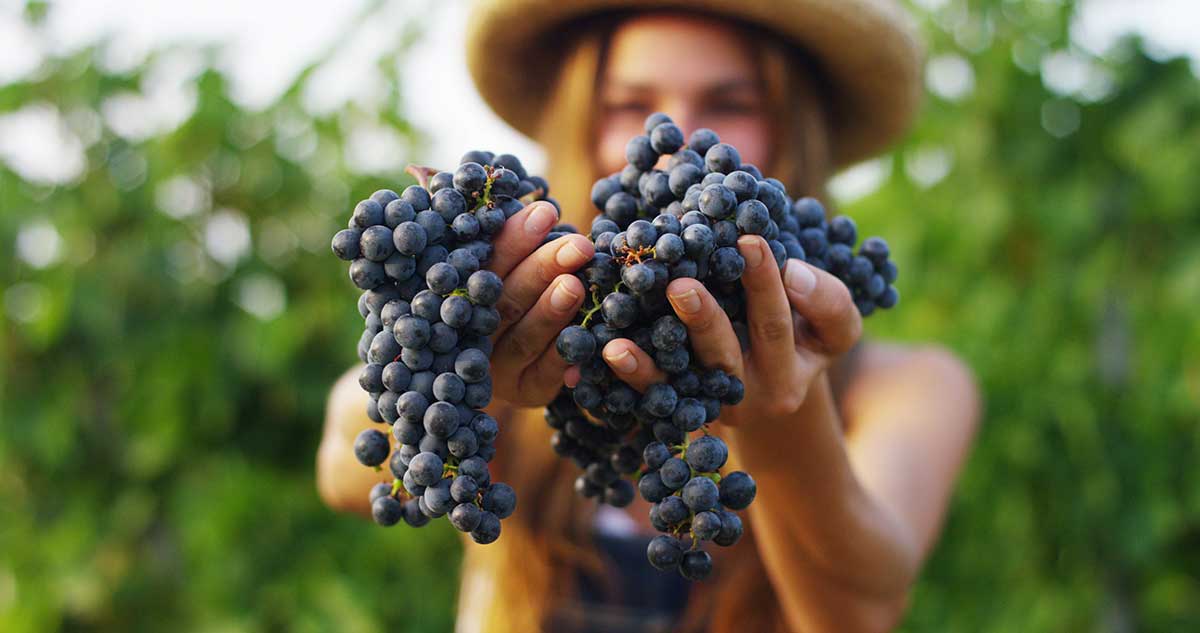Cretans harvest grapes from the middle of August until the beginning of October – depending on the purpose the fruit will serve and their varietals. About forty different varieties of grapes grow on the island, including native species like Kotsifali, Vidiano, Thrapsathiri, Liatiko, and Mandilaria, and foreign varieties including Merlot, Syrah, and Cabernet Sauvignon.
- Kotsifali is a red grape indigenous to the island. It produces a wine with high levels of alcohol. The Heraklion regional unit is the largest area where this type of grape is cultivated.
- Liatiko is a red grape used for sweet red or rose wines. It grows abundantly on Crete island, and it matures in July.
- Mandilaria is a red grape, which yields light-bodied wines with fruity plum and anise aroma.
- Romeiko is a Cretan grape cultivated mainly in the Chania regional unit. It is used to produce white, red, and rose wines and traditional Cretan marouvas wine.
- Vidiano is the star of the Cretan white wines. It is a white, aromatic grape, producing high-quality, moderate acidity wines with aromas of Cretan herbs and summer fruit.
- Thrapsathiri is another Cretan white grape, which produces aromatic wines with soft acidity.
The busiest grape harvesting month is September. Greeks call this fall activity “Trygos” – a Greek term meaning wine harvest. Local wineries on Crete offer harvest and facility tours coupled with wine tasting.
Outside wineries, farmers and villagers harvest their vineyards too, and the activity involves whole communities. There’s laughter all around as children and adults stomp the grapes barefoot in concrete troughs. Treading is the traditional way to “squeeze” the precious liquid out of the fruits. Moustalevria (the Greek name for fresh grape juice) will ferment for a couple of months before becoming wine. But you will get to taste last year’s vintage and raki, the Cretan hard liquor made from pomace left over after treading.
Main Products Derived from Grapes
Grapes are versatile, and Cretans use them for more than wine-making and consumption. Here are the main products derived from Dyonissos’s precious gifts to humankind:
Marouvas Wine
A high-alcohol red wine with a taste reminiscent of brandy, sherry, or Madeira wines, this wine is aged in oak barrels and consumed either as an aperitif or after a meal with a slice of cheese or a piece of fresh fruit.
Raki (Tsikoudia)
Cretans use the pomace after the grape treading to produce a very popular alcoholic beverage: Cretan raki, or tsikoudia, as the locals call it. Cretan raki is not the anise-flavored drink you will find on the mainland, Cyprus, or Turkey. Instead, it is closer to grappa but not so aromatic. Its alcoholic percentage can be anything between 30 and 45°. Cretans consume raki after every meal with fruit and desserts, but they also serve the drink when they welcome guests in their homes and with every joyous or less fortunate occasion in their lives. There’s a saying that perfectly encompasses the meaning of this drink for the locals: “raki unites people.” Please note that raki consumption is always associated with a meal and sharing food. Mezedes will always accompany the drink.
Rakomelo
Rakomelo is nothing but raki sweetened with honey. It is not as strong as tsikoudia because it is usually heated in a pan until the honey incorporates homogenously into the drink. Sometimes you can taste cinnamon, orange, or other flavors producers mix in to give the beverage a “signature” flavor. Usually favored by women, rakomelo is a dessert drink best served well- chilled.
Agourida
Agourida is a juice made from unripe grapes. You can use it instead of lemon or vinegar to season your salads. If you need to add some acidity to a soup or minestrone, this grape by-product will enhance your dish with a subtle aroma. Cretan mixologists use it for cocktails, too.
Petimezi (Grape Syrup)
Petimezi is grape juice boiled until thick. Sometimes it may have the consistency of a syrup, and, when boiled longer, it resembles molasses. It works nicely on pancakes and ice cream, but it is often used as a natural sweetener for coffee and instead of sugar in baking cookies and other desserts.
Stafidia (Raisins)
Edible grapes dried under the hot Cretan sun are stafidia=raisins. You can consume them as is or add them to a bowl of cereals in the morning, yogurt, cakes, and other desserts. Even savory dishes like gemista and meat taste great when you add raisins to the stuffing. Salads and raisins pair well, too.
Takeaway
From August until late September, if you are in Crete, join a grape harvest party to learn more about the local traditions, have fun, eat good food, and taste locally produced wines and grape by-products. Most Cretan wineries offer year-round tours and wine tastings. Look for a farm-to-table agritourism business for hands-on grape harvest experiences, especially if you want to participate in a barefoot grape treading extravaganza.
